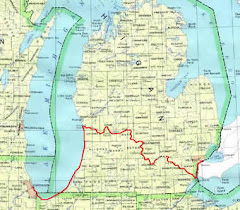 In memory of my late wife Elaine I have purchased a Dave Yost-designed Bell Rob Roy 15' KevLight decked solo canoe for my son Jim (also in memory of Elaine I bought daughter Karen a Pongo 140 kayak for the use of her large sons at her cottage on Black Lake and I'm going to buy her a Pongo 120 for herself).
In memory of my late wife Elaine I have purchased a Dave Yost-designed Bell Rob Roy 15' KevLight decked solo canoe for my son Jim (also in memory of Elaine I bought daughter Karen a Pongo 140 kayak for the use of her large sons at her cottage on Black Lake and I'm going to buy her a Pongo 120 for herself).I don't know how many of you are familiar with the Bell Rob Roy, but it is kind of a lightweight, shorter version of the Kruger Sea Wind that weighs in at about 40# and has about 8 or 9 fewer layers of Kevlar. It is a beautiful watercraft. I bought it through Ron Sell of Unadilla Boatworks on the Huron River near Dexter. Ron is a Bell dealer. We will be displaying the Rob Roy at the Quiet Water Symposium next March 7 at Michigan State University.
The point of this email is to alert you to the story of the Englishman John MacGregor who developed the original Rob Roy canoe and paddled versions of it for thousands of miles in Europe and the Middle East and wrote three books about these adventures. The parallels and contrasts between his story and Verlen Kruger's are very intriguing to me and I want to share them with you-all. If you are already familiar with MacGregor and the original Rob Roys, stop here.
John MacGregor lived from 1825 to1892. Verlen's life span was 1922 to 2004, thus they lived just a century apart. But while Verlen grew up a sharecropper's son, MacGregor's father was a General who fought against Napoleon. MacGregor had a degree in mathematics from Trinity College in Dublin and studied patent law at Cambridge. Verlen was a plumber's apprentice and plumbing contractor.
MacGregor toured Europe, the Middle East, Russia, North Africa, the United States, Canada and Siberia for pleasure. Verlen toured places like Texas, Japan and Korea thanks to being an Army tanker and a P-51 pilot in the Army Air Force during World War II.
MacGregor's fame as a canoeist came more than midway through life. Likewise Verlen didn't start canoeing until he was 41. Without question, they were the preeminent paddlers of their times.
MacGregor's books pertinent to this tale are A Thousand Miles in the Rob Roy Canoe, The Rob Roy on the Baltic and The Rob Roy on the Jordan, Red Sea and Genesareth. The illustrations in his books are his own.
Books about Verlen and his adventures are One Incredible Journey by Verlen and Clayton Klein, Valerie Fons' Keep It Moving, The Ultimate Canoe Challenge by Verlen and Brand Frentz and Phil Peterson Sr.'s All Things are Possible.
 MacGregor and Verlen both called their craft "canoes" though MacGregor used a double bladed paddle while Verlen used a single bladed paddle with a rudder. Both could be rigged for sailing. Both slept in their canoes when convenient or when circumstances demanded.
MacGregor and Verlen both called their craft "canoes" though MacGregor used a double bladed paddle while Verlen used a single bladed paddle with a rudder. Both could be rigged for sailing. Both slept in their canoes when convenient or when circumstances demanded.MacGregor was 6'6" tall. The dimensions of the Baltic Rob Roy were: Length 14', Stem to beam 7'6", Width (6" abaft of midships) 26", Depth from top of deck (at fore end of well) to top of keel 11", Outside depth of keel 1", Depth at gunwale 8 1/2", Well (cockpit) 32"x20", Weight 60#.
 Verlen was maybe a foot shorter than MacGregor. The dimensions of the Loon which he paddled on the 28,000 mile trip (from the Introduction to The Ultimate Canoe Challenge) are Length 17', Width 35", Cockpit about 5' long. Weight 60#.
Verlen was maybe a foot shorter than MacGregor. The dimensions of the Loon which he paddled on the 28,000 mile trip (from the Introduction to The Ultimate Canoe Challenge) are Length 17', Width 35", Cockpit about 5' long. Weight 60#.Here are the dimensions for the Sea Wind which evolved as improvements from the Loon (and Monarch). Verlen used the Sea Wind on the two-continent trip with Valerie: Length 17'2", Over all width 28.5", Width at 4" waterline 25", Middle depth 13.5", Cockpit 20"x87", Weight 63#. These specs are from the Kruger Canoes website. I am surprised at the difference in width between the Loon and the Sea Wind. Perhaps Mark P. can enlighten us.
The dimensions of Jim's Bell Rob Roy are: Length 15', Gunwale width 20.5", Maximum width 28.5", 3" Waterline width 25.5", Cockpit 18"x63". Weight 35-40#. He is 6'3" tall.
To be continued.



No comments:
Post a Comment